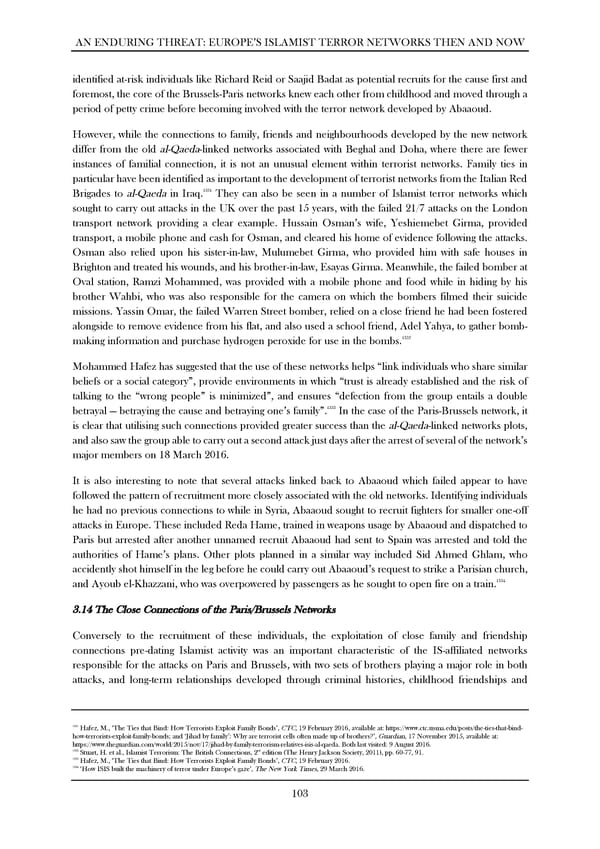AN ENDURING THREAT: EUROPE’S ISLAMIST TERROR NETWORKS THEN AND NOW identified at-risk individuals like Richard Reid or Saajid Badat as potential recruits for the cause first and foremost, the core of the Brussels-Paris networks knew each other from childhood and moved through a period of petty crime before becoming involved with the terror network developed by Abaaoud. However, while the connections to family, friends and neighbourhoods developed by the new network differ from the old al-Qaeda-linked networks associated with Beghal and Doha, where there are fewer instances of familial connection, it is not an unusual element within terrorist networks. Family ties in particular have been identified as important to the development of terrorist networks from the Italian Red 1331 Brigades to al-Qaeda in Iraq. They can also be seen in a number of Islamist terror networks which sought to carry out attacks in the UK over the past 15 years, with the failed 21/7 attacks on the London transport network providing a clear example. Hussain Osman’s wife, Yeshiemebet Girma, provided transport, a mobile phone and cash for Osman, and cleared his home of evidence following the attacks. Osman also relied upon his sister-in-law, Mulumebet Girma, who provided him with safe houses in Brighton and treated his wounds, and his brother-in-law, Esayas Girma. Meanwhile, the failed bomber at Oval station, Ramzi Mohammed, was provided with a mobile phone and food while in hiding by his brother Wahbi, who was also responsible for the camera on which the bombers filmed their suicide missions. Yassin Omar, the failed Warren Street bomber, relied on a close friend he had been fostered alongside to remove evidence from his flat, and also used a school friend, Adel Yahya, to gather bomb- 1332 making information and purchase hydrogen peroxide for use in the bombs. Mohammed Hafez has suggested that the use of these networks helps “link individuals who share similar beliefs or a social category”, provide environments in which “trust is already established and the risk of talking to the “wrong people” is minimized”, and ensures “defection from the group entails a double 1333 betrayal — betraying the cause and betraying one’s family”. In the case of the Paris-Brussels network, it is clear that utilising such connections provided greater success than the al-Qaeda-linked networks plots, and also saw the group able to carry out a second attack just days after the arrest of several of the network’s major members on 18 March 2016. It is also interesting to note that several attacks linked back to Abaaoud which failed appear to have followed the pattern of recruitment more closely associated with the old networks. Identifying individuals he had no previous connections to while in Syria, Abaaoud sought to recruit fighters for smaller one-off attacks in Europe. These included Reda Hame, trained in weapons usage by Abaaoud and dispatched to Paris but arrested after another unnamed recruit Abaaoud had sent to Spain was arrested and told the authorities of Hame’s plans. Other plots planned in a similar way included Sid Ahmed Ghlam, who accidently shot himself in the leg before he could carry out Abaaoud’s request to strike a Parisian church, 1334 and Ayoub el-Khazzani, who was overpowered by passengers as he sought to open fire on a train. 3.14 The Close Connections of the Paris/Brussels Networks Conversely to the recruitment of these individuals, the exploitation of close family and friendship connections pre-dating Islamist activity was an important characteristic of the IS-affiliated networks responsible for the attacks on Paris and Brussels, with two sets of brothers playing a major role in both attacks, and long-term relationships developed through criminal histories, childhood friendships and ! ! 1331 Hafez, M., ‘The Ties that Bind: How Terrorists Exploit Family Bonds’, CTC, 19 February 2016, available at: https://www.ctc.usma.edu/posts/the-ties-that-bind- how-terrorists-exploit-family-bonds; and ‘Jihad by family’: Why are terrorist cells often made up of brothers?’, Guardian, 17 November 2015, available at: https://www.theguardian.com/world/2015/nov/17/jihad-by-family-terrorism-relatives-isis-al-qaeda. Both last visited: 9 August 2016. 1332 nd Stuart, H. et al., Islamist Terrorism: The British Connections, 2 edition (The Henry Jackson Society, 2011), pp. 60-77, 91. 1333 Hafez, M., ‘The Ties that Bind: How Terrorists Exploit Family Bonds’, CTC, 19 February 2016. 1334 ‘How ISIS built the machinery of terror under Europe’s gaze’, The New York Times, 29 March 2016. ! ! 103 !
 An Enduring Threat: Europe’s Islamist Terror Networks Then and Now Page 107 Page 109
An Enduring Threat: Europe’s Islamist Terror Networks Then and Now Page 107 Page 109